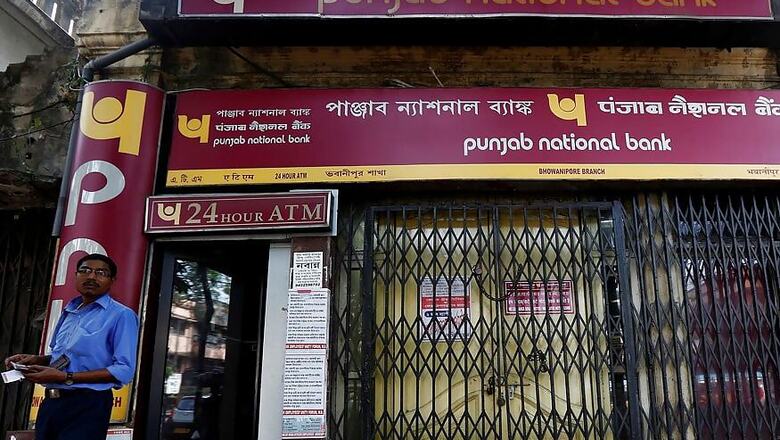
views
New Delhi: Punjab National Bank must be squirming these last few days, with what its punch line “trusted by millions since 1895” displayed across branches, on bank stationary and in all communication.Trust is a touchy topic for the bank this week, since India’s largest ever corporate fraud has been detected at one of its branches.
Though, the bank management reported the fraud itself, is keen on a full investigation and says will fulfill all the obligations arising from this Rs 11,000 odd crore bungling, it is obvious that taxpayers may have to foot this bill. After all, with government being the primary owner of this bank and already committed to continuously infuse capital in many public sector banks to keep them afloat, the tab will directly or indirectly be picked up by the government and by extension, the taxpayers. So while Nirav Modi, the alleged mastermind of this fraud, flees across continents, you and I will have to foot the bill for his extravaganza.
Specific to PNB, the government just infused Rs 5,473 crore as capital into the bank for this fiscal. This is the fifth largest capital infusion in state-owned banks by the government this year, with big daddy SBI getting Rs 8,800 crore.
The government has been infusing capital in banks to make them stronger since most have been struggling under bad loans – loans which were advanced to corporate entities without proper due diligence or lien, loans which eventually turned bad and loans which now have to be somehow provided for through government help.
PNB itself has seen the bad loans quantum almost double in just one year, as the table below shows. Between 2014-15 and 2015-16, gross NPAs (Non-performing assets) of the bank rose to 12.9% from just 6.55%.
In 2016-17 bad loans were a tad lower at 12.53% but there is little doubt that the Nirav Modi and related entities’ fraud is going to raise this ratio substantially.
During the year when bad loans were peaking for PNB, its bottom-line also slipped badly – from turning in a net profit of Rs 3,062 crore in 2014-15, it reported a net loss of Rs 3,874 crore in the immediately next fiscal. The bank has returned to profits in 2016-17, albeit at almost a third of what it reported in 2014-15.
Net profit since 2012 Gross NPAs (%)
2011-12: Rs 4884 crore 2011-12: 2.93
2012-13: Rs 4748 crore 2012-13: 4.27
2013-14: Rs 3343 crore 2013-14: 5.25
2014-15: Rs 3062 crore 2014-15: 6.55
2015-16: (-) Rs 3974 crore 2015-16: 12.9
2016-17: Rs 1325 crore 2016-17: 12.53
This state of affairs at one of India’s oldest and trusted banking brand names surely brings us to the question: Should the Indian government continue to fund state-run banks without ensuring transparent operations and clear risk management practices?
Not just PNB, other state owned banks are also witness to frauds. And, this is proved by publicly available data. In fact, the big daddy of India’s banking system, State Bank of India (SBI), is far ahead of PNB in terms of total cases of fraud reported in three years from 2014-15 to 2016-17.
According to a written reply in Lok Sabha on February 2 this year, the total number of fraud cases reported by SBI stood at 2,466 or more than two frauds a day. During the same period, PNB reported 471 cases of fraud.
If the PNB case in causing so much heartburn now, shouldn’t the government (which is the primary owner of public sector banks) focus on the goings on at other, larger banks like the SBI too? Yes, there is an RBI-dictated mechanism to detect and report fraud, but it is clearly not proving very effective.
In July last year, MoS Finance Santosh Kumar Gangawar, shared deeply disturbing figures of amounts under fraud at various public sector banks. Here, PNB topped the list – it had the largest amount under fraud – in 2016-17 at Rs 2,808.27 crore. That averages to Rs 7.7 crore every single day of the year. This amount was bigger than that declared by SBI, which was at Rs 2,422.37 crore.
There are various types of frauds at our banks. Some happen due to gaps in credit underwriting standards, some due to liberal cash flow projections at proposal stage, some others due to lack of continuous monitoring of cash flow and cash profits (EBITDA), some because of wilful diversion of funds and others happen due to various reasons.
The moot point is that funds which our banks classify as being under fraud are huge – the data quoted above say the total amount under all types of fraud at all banks (state-owned as well as private) was a staggering Rs 23,902.63 crore in 2016-17. In the last five years till 2016-17, PNB declared a loss of a staggering Rs 8,999.17 crore on account of frauds, again the highest among all state owned banks. In other words, it lost Rs 5 crore every single day due to frauds. SBI lost Rs 6,228.01 crore during the same period due to frauds.
Perhaps, it would be wise for the RBI and other officials concerned to revisit the guidelines on reporting fraud across state owned banks. Or we may be left fending for many more Nirav Modi like cases, where the perpetrator has fled and taxpayers are left holding the tab.
(The author is senior journalist. Views are personal)



















Comments
0 comment